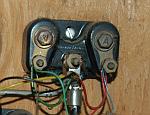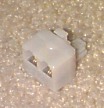If you fall within any of the scenarios below, you should work with the person who built the tester for you, or call your phone company and ask if they will send a representative to help you determine the point along the wire where your responsibility ends and theirs begins. Normally your responsibility ends at the interface box.

This is an interface box.

If you live in an apartment building, there may be a central interface box,

a patch block, or no interface at all. If you live in an older house, you may still have the older grounding blocks used before the breakup of the "Ma Bell" companies. If so, ask your phone company if they will install an interface box for you.

If you have more than one phone line in your house, the line you are trying to test may be on the 2nd pair of wires (black-yellow or white-orange). Also the phone company will sometimes use the second pair of wires if the primary pair has been damaged. If this is the case you may want to obtain a line splitter.
 This is a line splitter, not a duplex jack. They look the same but do not work the same. The line splitter will make each of its outlets active on a different line. The duplex jack simply allows you to plug 2 devices into the same line.
This is a line splitter, not a duplex jack. They look the same but do not work the same. The line splitter will make each of its outlets active on a different line. The duplex jack simply allows you to plug 2 devices into the same line.
If you report a problem and it turns out to be with either your equipment, or along the part of the wire you are responsible for, most phone companies will bill you for the service call.
I have tired to include most common scenarios, however there are many other possible wiring arrangements you may encounter. You should try to determine what kind of wiring system and any unusual wire or jack conditions you may have, when you first get your tester. That way you will be prepared when something goes wrong and won't have to try to figure out the complicated stuff when it breaks down.